(完整)仁爱版七年级英语上册总复习
- 格式:doc
- 大小:52.02 KB
- 文档页数:8
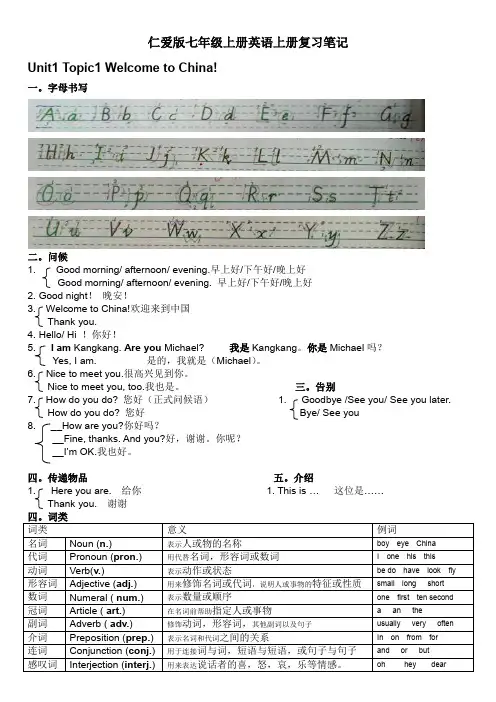
仁爱版七年级上册英语上册复习笔记Unit1 Topic1 Welcome to China!一。
字母书写二。
问候1. Good morning/ afternoon/ evening.早上好/下午好/晚上好Good morning/ afternoon/ evening. 早上好/下午好/晚上好2. Good night!晚安!3. Welcome to China!欢迎来到中国Thank you.4. Hello/ Hi !你好!5. I am Kangkang. Are you Michael? 我是Kangkang。
你是Michael吗?Yes, I am. 是的,我就是(Michael)。
6. Nice to meet you.很高兴见到你。
Nice to meet you, too.我也是。
三。
告别7. How do you do? 您好(正式问候语) 1. Goodbye /See you/ See you later.How do you do? 您好Bye/ See you8. __How are you?你好吗?__Fine, thanks. And you?好,谢谢。
你呢?__I’m OK.我也好。
四。
传递物品五。
介绍1. Here you are. 给你 1. This is …这位是……Thank you.谢谢四。
词类词类意义例词名词Noun (n.) 表示人或物的名称boy eye China代词Pronoun (pron.) 用代替名词,形容词或数词I one his this动词Verb(v.) 表示动作或状态be do have look fly 形容词Adjective (adj.) 用来修饰名词或代词,说明人或事物的特征或性质small long short数词Numeral ( num.) 表示数量或顺序one first ten second 冠词Article ( art.) 在名词前帮助指定人或事物 a an the副词Adverb ( adv.) 修饰动词,形容词,其他副词以及句子usually very often 介词Preposition (prep.) 表示名词和代词之间的关系In on from for连词Conjunction (conj.) 用于连接词与词,短语与短语,或句子与句子and or but感叹词Interjection (interj.) 用来表达说话者的喜,怒,哀,乐等情感。
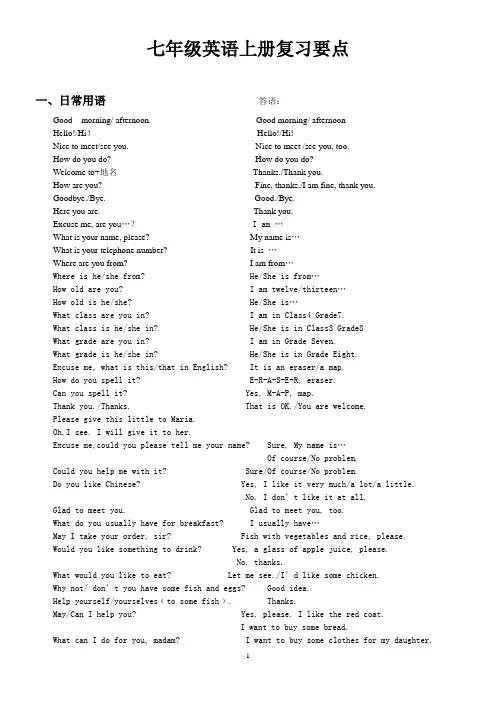
七年级英语上册复习要点一、日常用语答语:Good morning/ afternoon. Good morning/ afternoonHello!/Hi!Hello!/Hi!Nice to meet/see you. Nice to meet /see you, too.How do you do? How do you do?Welcome to+地名Thanks./Thank you.How are you? Fine, thanks./I am fine, thank you.Goodbye./Bye. Good./Bye.Here you are. Thank you.Excuse me, are yo u…? I am…What is your name, please? My name is…What is your telephone number? It is …Where are you from? I am from…Where is he/she from? He/She is from…How old are you? I am twelve/thirteen…How old is he/she? He/She is…What class are you in? I am in Class4 Grade7.What class is he/she in? He/She is in Class3 Grade8What grade are you in? I am in Grade Seven.What grade is he/she in? He/She is in Grade Eight.Excuse me, what is this/that in English? It is an eraser/a map.How do you spell it? E-R-A-S-E-R, eraser.Can you spell it? Yes, M-A-P, map.Thank you./Thanks. That is OK./You are welcome.Please give this little to Maria.Oh,I see. I will give it to her.Excuse me,could you please tell me your name? Sure, My name is…Of course/No problem,Could you help me with it? Sure/Of course/No problem.Do you like Chinese? Yes, I like it very much/a lot/a little.No, I don’t like it at all.Glad to meet you. Glad to meet you, too.What do you usually have for breakfast? I usually have…May I take your order, sir? Fish with vegetables and rice, please.Would you like something to drink? Yes, a glass of apple juice, please.No, thanks.What would you like to eat? Let me see./I’d like some chicken.Why not/ don’t you have some fish and eggs? Good idea.Help yourself/yourselves﹙to some fish﹚. Thanks.May/Can I help you? Yes, please. I like the red coat.I want to buy some bread.What can I do for you, madam? I want to buy some clothes for my daughter.I am just looking, thanks. How do you like the trousers? They are too long.What do you think of this yellow skirt? Oh I don ’t like it at all. Can I try it on? Sure.Is that all? Yes, I think so. How much is it? It is 280 yuan. How many bottles ? Six bottles.How heavy is it? It is one kilo a bag. How much rice do we need? One bag of rice.Would you like to go to the West Hill for a picnic? Oh, I ’d love/like to. Thanks. That would be very nice. Would you like to sing some songs with me? I am sorry I can ’t. I have to cook.How about flying a kite with me? I ’d like that, but I am sorry I have no time. What about having a picnic with Mr. Cooper? I ’d like that, thanks. Are you free this Sunday? Yes. What ’s up? May I speak to Maria? She isn ’t in now. Who ’s this? This is … Could you ask her to call me back this evening? Sure. Do have any time tomorrow?Let ’s meet at 9 o ’clock at my home. They are cute/strong/clever. They are so kind and they have long noses.What ’s up, Baby Monkey? I can ’t find my way home. Let me help you. Thank you. It ’s very kind of you. Thank you for your help. 二、语法 1、 be 动词的用法:be 动词有三种形式(am is are),意为“是”。

仁爱版七年级英语上册知识汇总Unit 1 Making New Friends【重点短语】1. good morning/ afternoon / evening 早上/下午/晚上好2. glad / nice to meet / see you 见到你很高兴3. welcome to + 地点欢迎来到……4. let’s + v让我们做……5. stand up 起立6. sit down 坐下7. this is... 这是……8. thanks = thank you 谢谢9. see you = see you later = goodbye 再见10. ID number 身份证号码11. be from=come from 来自12. in English 用英语【重要句型】1. ---What’s your name? ---My name is Sally.2. ---Where are you from? ---I’m from China.---Where do you come from? ---I come from China.3. ---Where is he/ she from? ---He/She is from Japan.4. ---What’s this/ that in English? --- It’s a/ an…5. ---What’re these/ those in English? ---They’re…6. ---How do you spell it? ---E-R-A-S-E-R, eraser.7. ---Can you spell it? ---Yes, M-A-P, map.8. —How old are you/ is he/ are they?—I’m/ He is/ They are eleven.9. —What’s your telephone number?—It’s 4567967.10. —What class/ grade are you in?—I’m in Class Ten, Grade Seven.(注意大小写)11. Good morning/ afternoon/ evening.12. —Hello!/Hi! —Hello!/Hi!13. —Nice/Glad to see/meet you. —Nice/Glad to see/meet you, too.14. —Welcome to China/my home. —Thanks.15. —How do you do? —How do you do?16. —How are you? —Fine, thank you. And you? —I’m OK.17. —See you then/ later. —See you.18. —Goodbye. —Bye.19. —Thank you. —You’re welcome./That’s OK./Not at all.【重点语法】1. 元音字母:Aa Ee Ii Oo Uu包含有以下元音的字母:[e] Aa Hh Jj Kk[i:] Ee Bb Cc Dd Gg Pp Tt Vv[aɪ] Ii Yy[ju:] Uu Qq Ww[e] Ff Ll Mm Nn Ss Xx Zz2. 大小写句首字母,人名,地名,称呼语,专有名词,星期的首字母要大写,引人注意。
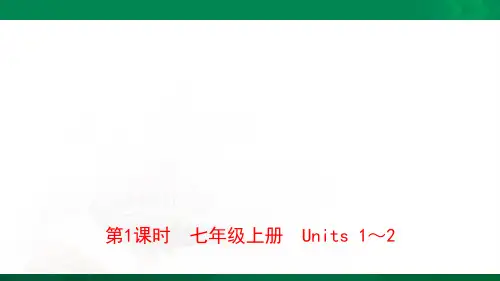
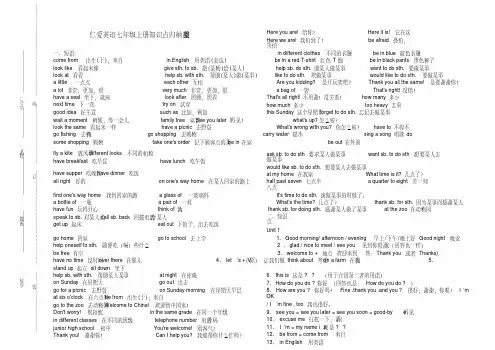
仁爱英语七年级上册知识点归纳完整版Here you are! 给你!Here it is! 它在这Here we are! 我们到了!be afraid 恐怕,害怕一、短语:in different clothes 不同的衣服be in blue 蓝色衣服come from 出生(于);来自in English 用英语(表达) be in a red T-shirt 红色 T 恤be in black pants 黑色裤子look like 看起来像give sth. to sb. 把(某物)给(某人) help sb. do sth.助某人做某事want to do sth. 要做某事look at 看着help sb. with sth. 帮助(某人)做(某事) like to do sth. 欢做某事would like to do sth. 要做某事a little 一点点each other 互相Are you kidding? 是开玩笑吧?Thank you all the same! 是要谢谢你!a lot 非常,更加,很very much 非常,更加,很 a bag of一袋That's right!没错!:号学线have a seat坐下,就座look after 照顾,照看next time 下一次try on 试穿good idea 好主意such as 比如,例如That's all right!不用谢!没关系!how many多少how much多少too heavy太重this Sunday这个星期日forget to do sth.忘记去做某事wait a moment 稍候,等一会儿family tree 家谱S ee you later再!见!what's up?怎么啦?look the same 看起来一样have a picnic 去野餐What's wrong with you?你怎么啦?have to不得不go fishing 去钓鱼go shopping 去购物carry water提水sing a song唱歌 do some shopping购物take one's order记下顾客点的菜be in 在家be out在外面:名姓fly a kite 放风筝different looks 不同的相貌have breakfast吃早餐have lunch 吃午饭ask sb. to do sth要. 求某人做某事want sb. to do sth想.要某人去做某事would like sb. to do sth.想要某人去做某事订have supper吃晚饭have dinner 吃饭all right 好的on one's way home 在某人回家的路上at my home在我家What time is it?几点了?half past seven七点半 a quarter to eight差一刻八点find one's way home 找到回家的路 a glass of 一玻璃杯It's time to do sth.该做某事的时候了。
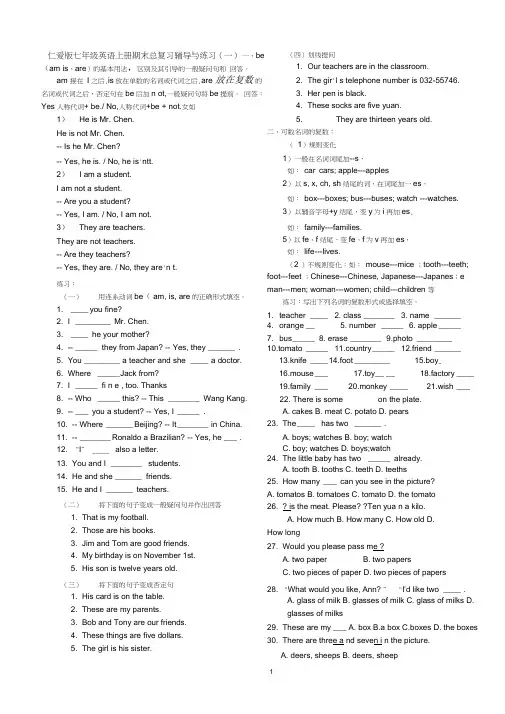
仁爱版七年级英语上册期末总复习辅导与练习(一)一、be (am is、are)的基本用法,区别及其引导的一般疑问句和回答。
am 接在I之后,is放在单数的名词或代词之后,are 放在复数的名词或代词之后,否定句在be后加n ot,—般疑问句将be提前。
回答:Yes人称代词+ be./ No,人称代词+be + not.女如1)He is Mr. Chen.He is not Mr. Chen.-- Is he Mr. Chen?-- Yes, he is. / No, he is'ntt.2)I am a student.I am not a student.-- Are you a student?-- Yes, I am. / No, I am not.3)They are teachers.They are not teachers.-- Are they teachers?-- Yes, they are. / No, they are'n t.练习:(一)用连系动词be( am, is, are的正确形式填空。
1. ____ you fine?2. I ________ Mr. Chen.3. ____ he your mother?4. -- _____ they from Japan? -- Yes, they ______ .5. You ________ a teacher and she ____ a doctor.6. Where _____ J ack from?7. I _____ fi n e , too. Thanks8. -- Who _____ this? -- This _______ Wang Kang.9. -- ___ you a student? -- Yes, I _____ .10. -- Where ______ Beijing? -- It _______ in China.11. -- _______ Ronaldo a Brazilian? -- Yes, he ___ .12. “I” _____ also a letter.13. You and I _______ students.14. He and she ______ friends.15. He and I ______ teachers.(二)将下面的句子变成一般疑问句并作出回答1. That is my football.2. Those are his books.3. Jim and Tom are good friends.4. My birthday is on November 1st.5. His son is twelve years old.(三)将下面的句子变成否定句1. His card is on the table.2. These are my parents.3. Bob and Tony are our friends.4. These things are five dollars.5. The girl is his sister.(四)划线提问1. Our teachers are in the classroom.2. The gir'l s telephone number is 032-55746.3. Her pen is black.4. These socks are five yuan.5. They are thirteen years old.二、可数名词的复数:(1)规则变化1)一般在名词词尾加--s,如:car cars; apple---apples2)以s, x, ch, sh结尾的词,在词尾加一es,如:box---boxes; bus---buses; watch ---watches.3)以辅音字母+y结尾,变y为i再加es,如:family---families.5)以fe、f结尾,变fe、f为v再加es,如:life---lives.(2 )不规则变化:如:mouse---mice ;tooth---teeth; foot---feet ;Chinese---Chinese, Japanese---Japanes;e man---men; woman---women; child---children 等练习:写出下列名词的复数形式或选择填空。

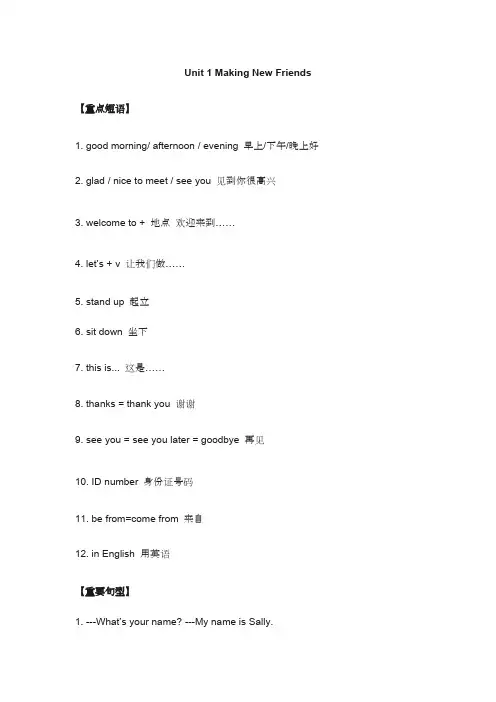
Unit 1 Making New Friends 【重点短语】1. good morning/ afternoon / evening 早上/下午/晚上好2. glad / nice to meet / see you 见到你很高兴3. welcome to + 地点欢迎来到……4. let’s + v 让我们做……5. stand up 起立6. sit down 坐下7. this is... 这是……8. thanks = thank you 谢谢9. see you = see you later = goodbye 再见10. ID number 身份证号码11. be from=come from 来自12. in English 用英语【重要句型】1. ---What’s your name? ---My name is Sally.2. ---Where are you from? ---I’m from China.---Where do you come from? ---I come from China.3. ---Where is he/ she from? ---He/She is from Japan.4. ---What’s this/ that in English? --- It’s a/ an…5. ---What’re these/ those in English? ---They’re…6. ---How do you spell it? ---E-R-A-S-E-R, eraser.7. ---Can you spell it? ---Yes, M-A-P, map.8. —How old are you/ is he/ are they?—I’m/ He is/ They are eleven.9. —What’s yourtelephone number?—It’s 4567967.10. —What class/ grade are you in?—I’m in Class Ten, Grade Seven.(注意大小写)11. Good morning/ afternoon/ evening.12. —Hello!/Hi! —Hello!/Hi!13. —Nice/Glad to see/meet you. —Nice/Glad to see/meet you, too.14. —Welcome to China/my home. —Thanks.15. —How do you do? —How do you do?16. —How are you? —Fine, thank you. And you? —I’m OK.17. —See you then/ later. —See you.18. —Goodbye. —Bye.19. —Thank you. —You’re welcome./That’s OK./Not at all.【重点语法】大小写句首字母,人名,地名,称呼语,专有名词,星期的首字母要大写,引人注意。
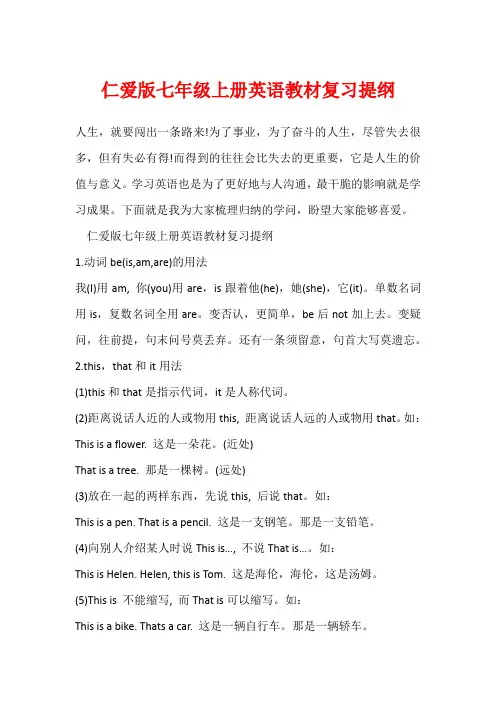
仁爱版七年级上册英语教材复习提纲人生,就要闯出一条路来!为了事业,为了奋斗的人生,尽管失去很多,但有失必有得!而得到的往往会比失去的更重要,它是人生的价值与意义。
学习英语也是为了更好地与人沟通,最干脆的影响就是学习成果。
下面就是我为大家梳理归纳的学问,盼望大家能够喜爱。
仁爱版七年级上册英语教材复习提纲1.动词be(is,am,are)的用法我(I)用am, 你(you)用are,is跟着他(he),她(she),它(it)。
单数名词用is,复数名词全用are。
变否认,更简单,be后not加上去。
变疑问,往前提,句末问号莫丢弃。
还有一条须留意,句首大写莫遗忘。
2.this,that和it用法(1)this和that是指示代词,it是人称代词。
(2)距离说话人近的人或物用this, 距离说话人远的人或物用that。
如:This is a flower. 这是一朵花。
(近处)That is a tree. 那是一棵树。
(远处)(3)放在一起的两样东西,先说this, 后说that。
如:This is a pen. That is a pencil. 这是一支钢笔。
那是一支铅笔。
(4)向别人介绍某人时说This is…, 不说That is…。
如:This is Helen. Helen, this is Tom. 这是海伦,海伦,这是汤姆。
(5)This is 不能缩写, 而That is可以缩写。
如:This is a bike. Thats a car. 这是一辆自行车。
那是一辆轿车。
(6)打电话时,介绍自己用this, 询问对方用that。
如:—Hello! Is that Miss Green? 喂,是格林小姐吗?—Yes, this is. Whos that? 是的,我是,你是谁?留意:虽然汉语中运用“我”和“你”,但英语中打电话时绝不行以说:I am…, Are you…?/Who are you?(7)在答复this或that作主语的疑问句时, 要用it代替this或that。
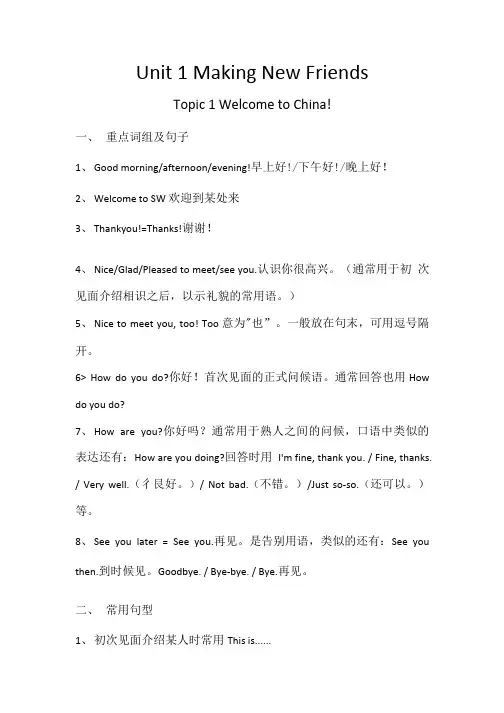
Unit 1 Making New FriendsTopic 1 Welcome to China!一、重点词组及句子1、Good morning/afternoon/evening!早上好!/下午好!/晚上好!2、Welcome to SW 欢迎到某处来3、Thankyou!=Thanks!谢谢!4、Nice/Glad/Pleased to meet/see you.认识你很高兴。
(通常用于初次见面介绍相识之后,以示礼貌的常用语。
)5、Nice to meet you, too! Too意为"也”。
一般放在句末,可用逗号隔开。
6> How do you do?你好!首次见面的正式问候语。
通常回答也用How do you do?7、How are you?你好吗?通常用于熟人之间的问候,口语中类似的表达还有:How are you doing?回答时用I'm fine, thank you. / Fine, thanks. / Very well.(彳艮好。
)/ Not bad.(不错。
)/Just so-so.(还可以。
)等。
8、See you later = See you.再见。
是告别用语,类似的还有:See you then.到时候见。
Goodbye. / Bye-bye. / Bye.再见。
二、常用句型1、初次见面介绍某人时常用This is......2、自我介绍用I'm xxx.3、询问对方是不是某人用Are you xxx?肯定回答用:Yes, I am.(注意不能缩写)否定回答用:No, Tin not.三、语法要点1、Be动词的用法Be动词有三个am, is, are。
Am只能跟I搭配;is用于单数主语的后面he, she , it或是xxx; are用于复数主语的后面you, they, we.2、一般疑问句的用法如何将陈述句改为一般疑问句(1)如果句中有Be动词或是情态动词can, could, will, would, may等直接把Be动词或情态动词提到句首。
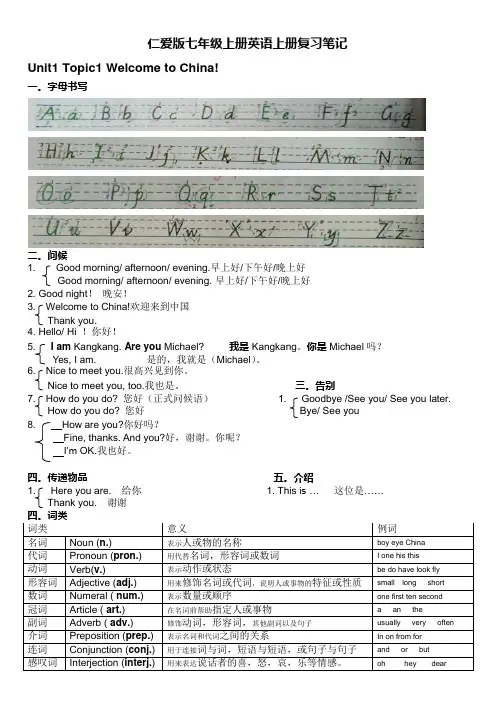
仁爱版七年级上册英语上册复习笔记Unit1 Topic1 Welcome to China!一。
字母书写二。
问候1. Good morning/ afternoon/ evening.早上好/下午好/晚上好Good morning/ afternoon/ evening. 早上好/下午好/晚上好2. Good night!晚安!3. Welcome to China!欢迎来到中国Thank you.4. Hello/ Hi !你好!5. I am Kangkang. Are you Michael? 我是Kangkang。
你是Michael 吗?Y e s, I am. 是的,我就是(M ichael)。
6. Nice to meet you.很高兴见到你。
Nice to meet you, too.我也是。
三。
告别7. How do you do? 您好(正式问候语) 1. Goodbye /See you/ See you later.How do you do? 您好Bye/ See you8. How are you?你好吗?Fine, thanks. And you?好,谢谢。
你呢?I’m OK.我也好。
四。
传递物品五。
介绍1. Here you are. 给你 1. This is …这位是……Thank you. 谢谢四。
词类词类意义例词名词Noun (n.) 表示人或物的名称boy eye China代词Pronoun (pron.) 用代替名词,形容词或数词I one his this动词Verb(v.) 表示动作或状态be do have look fly形容词Adjective (adj.) 用来修饰名词或代词,说明人或事物的特征或性质small long short 数词Numeral ( num.) 表示数量或顺序one first ten second冠词Article ( art.) 在名词前帮助指定人或事物 a an the副词Adverb ( adv.) 修饰动词,形容词,其他副词以及句子usually very often 介词Preposition (prep.) 表示名词和代词之间的关系In on from for连词Conjunction (conj.) 用于连接词与词,短语与短语,或句子与句子and or but感叹词Interjection (interj.) 用来表达说话者的喜,怒,哀,乐等情感。
一、短语:come from 出生(于); 来自look like 看起来像look at看着 a little 一点点 a lot非常,更加,很have a seat坐下,就座n ext time 下一次good idea 好主意wait a mome nt稍候,等一会儿look the same 看起来一样go fish ing去钓鱼do some shopp ing 购物fly a kite放风筝have breakfast 吃早餐have supper 吃晚饭all right 好的find on e's way home找到回家的路a bottle of 一瓶have fun玩得开心speak to sb.对某人说get up起床go home回家help on eself to sth.随便吃(喝)些什么be free有空have no time 没时间think about 考虑help sb. with sth.帮助某人某事on Sun day 在星期天go for a pic nic 去野餐at six o'clock 在六点钟go to the zoo 去动物园Don't worry!别担忧!in differe nt classes在不同的班级junior high school 初中Tha nk you!谢谢你!in English用英语(表达)give sth. to sb.把(某物)给(某人)help sb. with sth.帮助(某人)做(某事) each other 互相very much非常,更加,很look after照顾,照看try on试穿such as比如,例如family tree 家谱have a pic nic 去野餐go shopp ing 去购物take on e's order记下顾客点的菜differe nt looks不同的相貌have lunch 吃午饭have dinner 吃饭on on e's way home在某人回家的路上a glass of 一玻璃杯 a pair of 一双think of 认为call sb. back回拨电话给某人eat out下馆子,出去吃饭go to school 去上学over there在那儿on a farm在农场at night在夜晚go out出去on Sun day morni ng 在星期天早晨be from出生(于);来自Welcome to Chi na!欢迎到中国来!in the same grade 在同一个年级teleph one nu mber 电话号码You're welcome!别客气!Can I help you?我能帮你什么忙吗?Here it is!它在这be afraid恐怕,害怕be in blue蓝色衣服be in black pants 黑色裤子wa nt to do sth.要做某事would like to do sth.要做某事Thank you all the same!That's right!没错!how many 多少too heavy 太重forget to do sth忘记去做某事what's up?怎么啦?have to不得不sing a song 唱歌be out在外面wa nt sb. to do sth想要某人去做某事仁爱英语七年级上册知识点归纳完整版订' Here you are!给你!Here we are!我们到了!in different clothes 不同的衣服be in a redT-shirt 红色T 恤help sb. do sth.助某人做某事like to do sth.欢做某事Are you kidding?是开玩笑吧? a bag of 一袋That's all right!不用谢!没关系!how much 多少this Sun da y这个星期日See you later再见!What's wrong with you?你怎么啦?carry water 提水be in在家ask sb. to do sth要求某人做某事would like sb. to do sth想要某人去做某事at my home 在我家What time is it?几点了?half past seven七点半 a quarter to eight 差一刻八点It's time to do sth该做某事的时候了。
仁爱英语七年级上册知识点归纳完整版一、短语:come from 出生(于);来自in 用(表达)look like 看起来像give sth. to sb. 把(某物)给(某人)look at 看着help sb. with sth. 帮助(某人)做(某事) a little 一点点each other 互相a lot 非常,更加,很much 非常,更加,很have a seat 坐下,就座look after 照顾,照看next time 下一次try on 试穿good idea 好主意such as 比如,例如wait a moment 稍候,等一会儿family tree 家谱look the same 看起来一样have a picnic 去野餐go fishing 去钓鱼go shopping 去购物do shopping 购物take one's order 记下顾客点的菜fly a kite 放风筝different looks 不同的相貌have breakfast 吃早餐have lunch 吃午饭have supper 吃晚饭have dinner 吃饭all right 好的on one's way home 在某人回家的路上find one's way home 找到回家的路 a glass of 一玻璃杯a bottle of 一瓶 a pair of 一双have fun 玩得开心think of 认为speak to sb. 对某人说call sb. back 回拨电话给某人get up 起床eat out 下馆子,出去吃饭go home 回家go to school 去上学help oneself to sth. 随便吃(喝)些什么be free 有空have no time 没时间over there 在那儿think about 考虑on a farm 在农场help sb. with sth. 帮助某人某事at night 在夜晚on Sunday 在星期天go out 出去go for a picnic 去野餐on Sunday morning 在星期天早晨at six o'clock 在六点钟be from 出生(于);来自go to the zoo 去动物园Welcome to China! 欢迎到中国来!Don't worry! 别担忧!in the same grade 在同一个年级in different classes 在不同的班级telephone number 电话号码junior high school 初中You're welcome! 别客气!Thank you! 谢谢你!Can I help you 我能帮你什么忙吗?Here you are! 给你!Here it is! 它在这Here we are! 我们到了!be afraid 恐怕,害怕in different clothes 不同的衣服be in blue 蓝色衣服be in a red T-shirt 红色T恤be in black pants 黑色裤子help sb. do sth. 助某人做某事want to do sth. 要做某事like to do sth. 欢做某事would like to do sth. 要做某事?Are you kidding 是开玩笑吧?Thank you all the same! 是要谢谢你!a bag of一袋That's right!没错!That's all right!不用谢!没关系!how many多少how much多少too heavy太重this Sunday这个星期日forget to do sth.忘记去做某事See you later!再见!'s up怎么啦?'s wrong with you你怎么啦?have to不得不carry water提水sing a song唱歌be in在家be out在外面ask sb. to do sth.要求某人做某事want sb. to do sth.想要某人去做某事would like sb. to do sth.想要某人去做某事at my home在我家What time is it几点了?half past seven七点半 a quarter to eight差一刻八点It's time to do sth.该做某事的时候了。
七年级上册Unit 1 Making New FriendsTopic 1 Welcome to China!重点:1. 字母(1)26个英语字母的大小写形式(2)5个元音字母:Aa Ee Ii Oo Uu2. 交际英语(1)—Good morning! —Good afternoon!—Good evening!—Good night!—Good morning! —Good afternoon!—Good evening!—Good night!早上好!下午好!晚上好!晚安!(2)Thank you.=Thanks.谢谢。
(3)—Hello/Hi!—Hello/Hi!你好!(4)—How do you do ?—How do you do ?你好!(初次见面)(5)—How are you ? 你好!—I`m fine(OK),thank you (thanks).我很好,谢谢!(6)—Nice to meet /see you.见到你很高兴。
—Nice to meet/see you,too。
见到你也很高兴。
(7)—See you later.再见。
—Good bye.再见。
—See you. —Good bye./Bye-bye.?/Bye.3. 短语(1)welcome to 欢迎到…..4. 句型(1)—I am Kangkang.Are you Michael?我是康康。
你是迈克尔吗?—Yes,I am.是的,我是。
/No,I`m not.不,我不是。
(2)This is Michael. 这是迈克尔。
This is Miss Wang. 这是王老师。
This is +人/物用来给对方介绍人或者物等。
5. 语法Be动词I用am, You用are,is跟着他她它;单数用is,复数就用are;变疑问,提前它;变否定,更容易,be后not加上去;疑问否定任你变,句首大写莫忘记,句末问号莫忘记。
仁爱版七年级英语上册总复习集团标准化办公室:[VV986T-J682P28-JP266L8-68PNN]英语七年级上册知识点归纳Unit11、Goodmorning/afternoon/evening早上/下午/晚上好Goodnight晚安(晚上告别)2、glad/nicetomeet/seeyou见到你很高兴(回答也一样)3、welcometo+地点欢迎来到……(回答:Thankyou或者Thanks)4、let’s+V让我们做……(原)5、standup起立sitdown坐下6、thisis-----这是……(用于介绍第三者的用语)7、Howdoyoudo你好(回答也是:Howdoyoudo)8、Howareyou你好吗Fine,thankyou.andyou很好;谢谢;你呢I’mOK/I’mfine,too.我也很好。
9、seeyou=seeyoulater=seeyousoon=good-bye再见10、excuseme打扰一下;请问11、I’m-----=mynameis----我是……12、befrom=comefrom来自13、inEnglish用英语14、CanyouspellitYes/No你能拼写它吗能/不能15、That’sOK/That’sallright/You’rewelcome/Notatall不用谢16、……yearsold?……岁17、telephonenumber电话号码QQnumberQQ号码IDnumber身份证18、thesame(相同的)反义词是different(不同的)例:Weareinthesamegrade,butweareindifferentclasses.句型:1.Whatisyourname你的名字是什么2.Where+be+主语+from某人来自于哪里(回答:主语+be+地点)Whereareyoufrom?Iamfromquanzhou.3.Howold+be+主语某人几岁(回答:主语+be+数字)例:Howoldareyou?I’mforteen.4.Whatisyourtelephonenumber你的电话号码是多少(回答:Mytelephonenumberis----或者It’s-------)注意:读出号码的时候要逐个读出。
仁爱版英语七年级上册全部知识点归纳仁爱版英语七年级上册的全部知识点归纳如下:1. 问候与自我介绍- 问候用语:Hello! Hi! Good morning! Good afternoon! Good evening!- 自我介绍:My name is [name]. I am [age] years old. I am from [country/city].2. 日常用语- 告别用语:Goodbye! See you! Bye!- 感谢用语:Thank you! Thanks!3. 询问与回答- 询问姓名:What's your name? My name is [name].- 询问年龄:How old are you? I am [age] years old.- 询问国籍:Where are you from? I am from [country/city].4. 课堂用语- 请坐:Please sit down.- 谢谢:Thank you. Thanks.- 请回答:Please answer.5. 数字与计数- 数字:1 (one), 2 (two), 3 (three), 4 (four), 5 (five), 6 (six), 7 (seven), 8 (eight), 9 (nine), 10 (ten)- 计数:How many...? There are [number]...6. 问路与指路- 问路:Excuse me. Where is...? How can I get to...?- 回答:Go straight. Turn left/right. It's on your left/right.7. 日常活动与时间表达- 日常活动:get up, have breakfast/lunch, go to school, have classes, do homework, have dinner, go to bed- 时间表达:in the morning/afternoon/evening, at [time], on [day]8. 询问与回答喜好- 询问:What's your favorite...? Do you like...? What do you like to do...?- 回答:My favorite... is... Yes, I do. No, I don't. I like to...9. 衣物与颜色- 衣物:hat, T-shirt, dress, skirt, pants, shoes- 颜色:black, white, red, blue, green, yellow, orange, purple, pink, brown10. 学校与学习- 学校:classroom, library, playground, computer room- 学习:study, read, write, listen, speak11. 爱好与运动- 爱好:swim, dance, sing, draw, play the piano, play basketball/football/volleyball - 运动:basketball, football, volleyball, table tennis, badminton以上是仁爱版英语七年级上册的全部知识点归纳,希望对你有所帮助!。
英语七年级上册知识点归纳Unit 11、Good morning/ afternoon / evening 早上/下午/晚上好Good night 晚安(晚上告别)2、 glad / nice to meet / see you 见到你很高兴(回答也一样)3、 welcome to + 地点欢迎来到……(回答:Thank you 或者Thanks)4、let’s + V(原)让我们做……5、 stand up 起立sit down 坐下6、 this is----- 这是……(用于介绍第三者的用语)7、 How do you do ?你好(回答也是:How do you do ? )8、 How are you ? 你好吗?Fine ,thank you .and you ? 很好;谢谢;你呢?I’m OK / I’m fine , too . 我也很好。
9、 see you = see you later = see you soon = good-bye 再见10、 excuse me 打扰一下;请问11、 I’m -----= my name is ---- 我是……12、 be from = come from 来自13、 in English 用英语X Kb 1.C om14、Can you spell it ? Yes / No 你能拼写它吗?能/不能15、 That’s OK / That’s all right / You’re welcome / Not at all 不用谢16、……years old ……岁17、 telephone number 电话号码QQ number QQ号码ID number 身份证18、the same (相同的)反义词是different (不同的)例: We are in the same grade, but we are in different classes.句型:1. What is your name ? 你的名字是什么?2. Where +be + 主语+ from? 某人来自于哪里?(回答:主语+be+地点)Where are you from? I am from quanzhou.3. How old + be + 主语?某人几岁?(回答:主语+ be + 数字)例:How old are you ? I’m forteen.4. What is your telephone number? 你的电话号码是多少?(回答:My telephone number is----或者It’s -------)注意:读出号码的时候要逐个读出。
5. What class / grade +be + 主语+ in ? 某人在哪一个班级/年级?例:what class are you in ? I am in Class Five. (注意:Class 和Five需要大写)what grade are you in ? I am in Grade Seven.(注意:Glass 和Seven需要大写)6. What’s this/ that (in English) ? 这是什么?(回答:I t’s a/an + 单数名词. 这是……)What’ re these/ those (in English) ? 这些是什么?(回答:They’re + 复数名词这些是……)7. How do you spell it ? 你怎么拼写它?E-R-A-S-E-R, eraser. (注意拼读方法)Unit 21、sb + has/ have ( an /a ) + adj + 五官 === sb’s 五官is / are + adj (描述长相)例:Lily has a small nose. = Lily’s nose is small.2、 I know = I see 我明白了3、 That’s right 那是对的4、 look the same look like 看起来相像look different 看起来不同例:Jim and Lilei look the same.== Jim looks like Lilei. .5、 look at + n 看某物look for +n 寻找某人/某物look after +n 照顾某人6、both 两者都……all 三者或者三者以上都……Both 和all位于be动词或情态动词后,位于行为动词前。
例:We are both students. We both have black eyes. We can both speak English.7、 give sth to sb = give sb sth 把某物给某人;(注意:如果sth是it或them,只能用前者)8、 have different looks == look different 有着不同的长相(看起来不相像)have the same look. ==look the same 有着相同的长相(看起来很相像)9、over there 在那边come in 请进go out 出去10、 in + 颜色或in a/an/the +颜色+ 衣服表示穿着……颜色的衣服常常接在名词的后面,表示穿----颜色衣服的……如the girl in red is my sister.11、 too + adj 太……12、pants 和shoes 做主语,谓语动词用复数;但a pair of pants/ shoes作主语时,谓语动词用单数形式例:His shoes are black. A pair of shoes is under the bed.13、in the morning/ afternoom/ evening 在早上/下午/晚上at night 在晚上14、 go shopping = go to the shop 去购物类似的有go swimming go fishing go skating 等等15、 help sb. ( to ) do sth == help sb with sth 帮助某人做某事注意:sb 用代词时必须用宾格16、high school 中学17、 play +球类play the 乐器18、think of 认为,想think about 考虑I think + 从句我认为……I think he you are right. 否定式常否定主句,但翻译时要否定后面的从句例:I don’t think he can come. 我认为他不会来了.(不能说:我不认为他会来)句型:1、 What do/does + 主语+ look like ? 询问人的长相例:What does your English teacher look like ?2、What’s -----and ------? ……加……是什么?(回答:It’s ------)例:What’s red and yellow? It’s orange. What’s two and five? It’s seven.3、Whose + 东西+ is this/ that ? Whose + 东西+are these/ those ? 这/这些是谁的……?例:Whose coat is this ? It is mine. Whose shoes are these ? They are hers.4、Who is the letter from? 这封信来自于谁?It’s from Lily. 它来自于莉莉。
5、What color be + 东西?(回答:It’s +颜色或者They’er + 颜色)例:What color is your dress? It’s black.Unit 31、 Could you (please)……(后接动词原形)你愿意做某事吗?May I ……(后接动词原形)我能做某事吗?2、the English corner 英语角3、live in + 地点住在某地live with + 人和某人住在一起4、What does he say in the letter? 他在信里说了些什么?What does he say on the photo? 他在电话里说了些什么?5、 a lot = very much 放在句末,修饰动词,非常……例:I like the boy a lot/ very much.not at all 一点也不……例:I don’t like the boy at all..6、each other 相互,彼此students often talk to each other in class.7、 do sth with sb 和某人一起做某事8、 No problem 没问题9、 speak + 语言说某种语言speak English speak Chinese10、the Great Wall 长城11、 come/go to + 地点去某地但home 、here 、there这些是副词,前面不能加to例:go home / come here / go therego to do sth 去做某事例:They go to play basketball.12、 like doing sth 喜欢做某事like to do sth 喜欢做某事13、 It’s + adj +to sb 对某人来说是……的X k B 1 . c o m14、help sb with sth =help sb (to) do sth 帮助某人某事15、be at home = be in 在家go home 回家get home到家in one’s home 在某人的家里16、 have a seat / take a seat / sit down 请坐下17、 office worker 办公室职员cook 厨师cooker炊具18、 on a farm 在农场上on the sofa 在沙发上19、 a photo of one’s family 某人的全家照Family Tree 家谱(首字母都大写)20、in a hospital 在医院(纯属地点概念)in hospital 因病住院例:He is ill in hospital. 他生病住院He is in a hospital.他在医院里(不一定是因为生病来到医院) 21、 look after sb = take care of sb 照顾某人22/ teach sb sth = teach sth to sb 教某人某东西teach sb to do sth 教某人做某事21、 help oneself ( to sth. ) 请随便(吃……)help yourself/ yourselves (to fish)22、 I’d like sth = I would like sth. 我想要……24、Would like to do sth = want to do sth 想要做某事25、Would you like something to eat (drink)? 你想要一些吃(喝)的东西吗?to eat 或to drink 修饰something,作为后置定语。